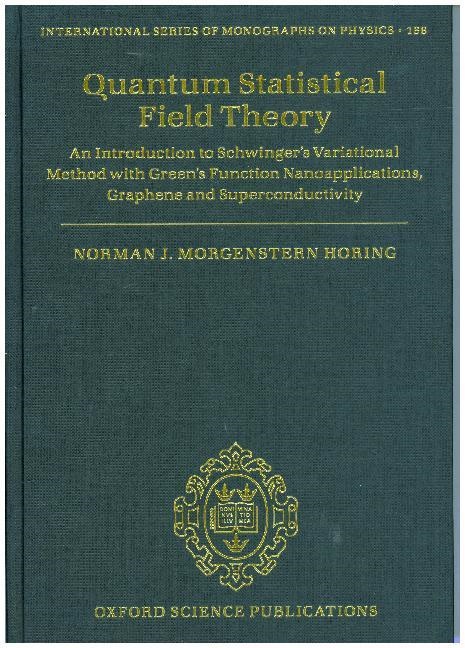Read more
This book provides an introduction to the methods of coupled quantum statistical field theory and Green's functions. The methods of coupled quantum field theory have played a major role in the extensive development of nonrelativistic quantum many-particle theory and condensed matter physics. This introduction to the subject is intended to facilitate delivery of the material in an easily digestible form to advanced undergraduate physics majors at a relatively early stage of their scientific development. The main mechanism to accomplish this is the early introduction of variational calculus and the Schwinger Action Principle, accompanied by Green's functions. Important achievements of the theory in condensed matter and quantum statistical physics are reviewed in detail to help develop research capability. These include the derivation of coupled field Green's function equations-of-motion for a model electron-hole-phonon system, extensive discussions of retarded, thermodynamic and nonequilibrium Green's functions and their associated spectral representations and approximation procedures. Phenomenology emerging in these discussions include quantum plasma dynamic-nonlocal-screening, plasmons, polaritons, linear electromagnetic response, excitons, polarons, phonons, magnetic Landau quantization, van der Waals interactions, chemisorption, etc. Considerable attention is also given to low dimensional and nanostructured systems, including quantum wells, wires, dots and superlattices, as well as materials having exceptional conduction properties such as Superconductors, Superfluids and Graphene.
List of contents
- 1: Dirac Notation and Transformation Theory
- 2: Identical Particles and Second Quantization: Occupation Number Representation
- 3: Q.M. Pictures; Heisenberg Eqn.; Linear Response; Superoperators and Non-Markovian Eqns.
- 4: Schwinger Action Principle and Variational Calculus
- 5: Retarded Green's Function
- 6: Quantum Mechanical Ensemble Averages and Statistical Thermodynamics
- 7: Thermodynamic Green's Functions and Spectral Structure
- 8: Equations of Motion with Particle-Particle Interactions and Approximations
- 9: Nonequilibrium Green's Functions; Variational Relations and Approximations for Particle Interactions
- 10: RPA Plasma Phenomenology, Semiclassical and Hydrodynamic Models
- 11: Interacting Electron-Hole-Phonon System
- 12: Graphene
- 13: Superfluidity and Superconductivity
About the author
Norman J. Morgenstern Horing's research activities started as a doctoral student with Prof. J. Schwinger at Harvard University, employing thermal Green's function methods to determine the Landau quantized plasmon spectrum. During the period 1960-1965 he worked at the MIT Lincoln and National Magnet Laboratories, followed by positions as a Visiting Lecturer at the Cavendish Laboratory, Cambridge University and then as a Staff Physicist at the U.S. Naval Research Laboratory, Washington, D.C. (1965-1966). Having progressed through the professorial ranks at Stevens Institute of Technology, he is now retiring as Emeritus Professor. He has worked extensively on the dielectric and transport properties of semiconductors (often focused on the role of a magnetic field) using the methods of coupled quantum statistical field theory, contributing over 300 scientific publications, including various book chapters and five books.
Summary
This book provides an introduction to the methods of coupled quantum statistical field theory and Green's functions. The methods of coupled quantum field theory have played a major role in the extensive development of nonrelativistic quantum many-particle theory and condensed matter physics. This introduction to the subject is intended to facilitate delivery of the material in an easily digestible form to advanced undergraduate physics majors at a relatively early stage of their scientific development. The main mechanism to accomplish this is the early introduction of variational calculus and the Schwinger Action Principle, accompanied by Green's functions. Important achievements of the theory in condensed matter and quantum statistical physics are reviewed in detail to help develop research capability. These include the derivation of coupled field Green's function equations-of-motion for a model electron-hole-phonon system, extensive discussions of retarded, thermodynamic and nonequilibrium Green's functions and their associated spectral representations and approximation procedures. Phenomenology emerging in these discussions include quantum plasma dynamic-nonlocal-screening, plasmons, polaritons, linear electromagnetic response, excitons, polarons, phonons, magnetic Landau quantization, van der Waals interactions, chemisorption, etc. Considerable attention is also given to low dimensional and nanostructured systems, including quantum wells, wires, dots and superlattices, as well as materials having exceptional conduction properties such as Superconductors, Superfluids and Graphene.
Additional text
This is a wonderful text, offering many gems and insights, which will be invaluable to anyone interested in condensed matter field theory. The text offers a comprehensive treatment of many applications of many-particle Greens Functions in a very logical manner.
Report
This is a wonderful text, offering many gems and insights, which will be invaluable to anyone interested in condensed matter field theory. The text offers a comprehensive treatment of many applications of many-particle Greens Functions in a very logical manner. Charlie Nation, Contemporary Physics

